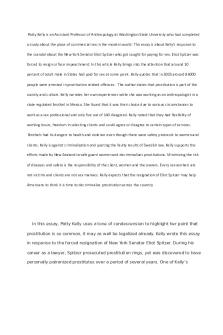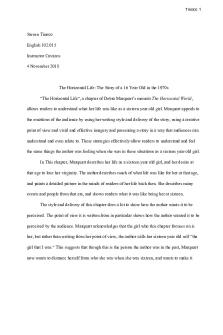Rhetorical Analysis of \"Antibiotic Apocalypse\" PDF

| Title | Rhetorical Analysis of \"Antibiotic Apocalypse\" |
|---|---|
| Course | Introductory Composition |
| Institution | Athabasca University |
| Pages | 5 |
| File Size | 349.9 KB |
| File Type | |
| Total Downloads | 33 |
| Total Views | 160 |
Summary
Download Rhetorical Analysis of "Antibiotic Apocalypse" PDF
Description
Rasadu 1 Georgela Rasadu Professor Sharren Patterson English 255 10 July 2020 Rhetorical Analysis of “Antibiotic Apocalypse”
Commented [A1]: Excellent formatting
th
In article “Antibiotic Apocalypse” published on September 29 , 2016, the well-known journalist and broadcaster, Gwynne Dyer, aims to persuade the general public that the inappropriate use of antibiotics needs to stop immediately to prevent their resistance in bacteria.
Commented [A2]: Strong opening sentence.
Dyer’s purpose is to convince his readers that the irresponsible use of antibiotics is the main cause of antibiotic resistance, one of the world’s most urgent public health problems. After
Commented [A3]: Yes
shedding light on the enormous and irresponsible use of antibiotics, Dyer points out that world leaders acknowledged this concerning trend of rising antibiotic resistance, however, there is
Commented [A4]: Comma splice
more to be done to stop it. Then, he explains how bacteria become resistant and claims that the only way to fight this is to use antibiotics responsibly. He concludes his article trying to convince his readers that the inappropriate use of antibiotics must stop at once, and everyone has a direct responsibility to do their part. In “Antibiotic Apocalypse,” Dyer’s thesis is that the misuse of
Commented [A5]: Very good brief summary of the article.
antibiotics must stop before they lose their effectiveness and common diseases start claiming lives again. Dyer conveys this message by using first-person pronouns and emotionally loaded language, supplemented by exemplification such as numbers and statistical representations.
Commented [A6]: Your thesis/map is nice and clear.
Dyer begins his article by using repeated first-person singular pronouns to express his point of view about the wrongdoings causing the rise in antibiotic resistance and the punishments “offenders should face” for using antibiotics in farming. Thus, Dyer says, “I have never advocated that people ... should be executed without trial.” trial”. The readers can see that Here, the author
Commented [A7]: Strong topic sentence.
Rasadu 2 employs first-person point of view at the beginning of his article to share with his audience his own opinion. emotions. Later, Dyer employs the use of first-person pronouns when he clarifies that he “was not really recommending the death penalty.” The use of first-person pronoun “I” gives these lines a glimpse into the author’s feelings of frustration when it comes to the improper use of
Commented [A8]: Wordiness
antibiotics in feeding the livestock. This helps the author accomplish his purpose by getting his readers’ attention on the main topic of this article, before going further with his thesis.
Commented [A9]: Good examples.
After using the “I” pronoun to express his opinions, Dyer shifts to the use of the firstperson plural pronoun, “we,” which is repeated throughout the rest of his article. First, “we” is
Commented [A10]: Yes, and this is very important. You’ve written a very good topic sentence.
employed to make the readers acknowledge that the proper use of antibiotics is everyone’s responsibility. This is transmitted successfully through a statement warning message such as
Commented [A11]: Precisely.
this: “if we don’t stop the rot we are heading back to the 19th century.” The use of “we” makes
Commented [A12]: Statement/message – same thing - so wordy
readers feel like having a dialog with the author, which continues until the end of this article.
Commented [A13]: Place colons only after complete sentences.
This also sets the scene for Dyer’s call for action which comes next, when he argues that “we are not doing” anything to stop “the reckless misuse of antibiotics.” Further, the author uses the firstperson plural pronoun in concluding his article, while pointing out that “we ... need a whole new
Commented [A14]: Excellent job smoothly integrating these quotations into your own sentences.
generation of antibiotics.” The use of two first person pronouns, “I” and “we,” provides both an authoritative opinion and a dialogue with the audience. gives these lines the quality of having a first-person point of view and a dialogue with the audience. Moreover, Dyer is subconsciously
Commented [A15]: Wordy/awkward.
making his readers agree with him by often incorporating the word “we.” He also makes them feel like they are all contributing the same amount of effort to the same cause. The audience
Commented [A16]: Yes, exactly.
starts to believe that they are greatly responsible for the rise in antibiotic resistance, rise situation and everybody has an ethical responsibility to prevent the spread of resistant bacteria.
Commented [A17]: Very good job with your paragraph.
Rasadu 3 In addition to first-person pronouns, Dyer uses the use of emotionally loaded language helps Dyer to set a fearful tone mood throughout the entire article. The name of the article,
Commented [A18]: Wordy/awkward. The words “throughout” and “entire” mean the same thing.
“Antibiotic Apocalypse,” demonstrates the author’s intention to discuss about a life-threatening challenging matter. Dyer utilizes the metaphor of the apocalypse to highlight the consequences
Commented [A19]: Apocalypse suggests much more than a challenge.
of the diminishing power of antibiotics. This frames the issue of antibiotic resistance in an extremely negative, end-of-world way, as the image of an apocalypse evokes a frightening
Commented [A20]: Good!
scenario where human action seems futile and human beings are helpless. The use of this
Commented [A21]: Very well said.
metaphor has a powerful impact on the audience due to its visual, lasting picture and breaks down any resistance the readers might have before reading the article. Adding to this idea, Dyer uses grim words through the entire article such as “death penalty”, “risk of death”, “biggest
Commented [A22]: Comma placement errors
killer” and “threat.” This choice of words describing the consequences of antibiotic resistance has a powerful negative connotation. The meaning of fatal led the audience understand that this
Commented [A23]: Yes, absolutely. Good point.
crisis is something not only to acknowledge, but rather one in which death cannot be avoided
Commented [A24]: Highly unclear
without taking steps to correct it.
Commented [A25]: On the whole – a very strong paragraph.
Another rhetorical device employed by Dyer is exemplification, specifically the use of numbers and statistical representations. This does not only strengthen his thesis, but it also teaches his readers that “the proportion of …[a] standard antibiotic ... has risen from 30 percent to 48 percent in ... the past ten years.” These numbers illustrate the gravity of the situation and the sense of urgency for remedial actions. In addition, Dyer supplies some few medical data that
Commented [A26]: Yes, they do. Good examples.
support his argument. An example where this strategy is emphasized he emphases this strategy
Commented [A27]: Wrong word/spelling
is when he points out that “at least 190,000 people worldwide died of tuberculosis” in 2015. This high number of victims explains why drug resistance became one of the world’s most urgent problems. After utilizing statistics to describe the extensive damage caused by antibiotic
Commented [A28]: Missing possessive apostrophe
Rasadu 4 resistance, Dyer points out that “80 percent of American antibiotic production” is used in feeding the livestock, mostly to compensate for the animals’ improper living conditions. This example has a strong impact on the audience as it emphasizes the extensive wrongdoings whose price is eventually paid by everyone through the rise in antibiotic resistance. The use of exemplifications,
Commented [A29]: Explain why this matters. Why is it a problem to use antibiotics with livestock.
as a result, helps the audience visualize the seriousness of the threat of the rising antibiotic resistance and its impact on human health and creates a sense of urgency for in the readers to care about the human health regarding antibiotic resistance. This data makes it easy to
Commented [A30]: Awkward/wordy
conceptualize the consequences of using antibiotics irresponsibly and contributes effectively to the overall argument. Overall, in his article “Antibiotic Apocalypse,” Dyer hits the predictability mark by using first-person pronouns, exemplifications and emotionally loaded language. Raising the alarm
Commented [A31]: Good points in this paragraph. Some writing issues. Commented [A32]: Unclear phrasing. Eliminating the word “predictability” solves the problem.
about antibiotic resistance and describing the seriousness of this threat, Dyer demonstrates the extent to which that the human health is at risk. Moreover, his audience becomes aware of the need to control the misuse of antibiotics and to take immediate actions to stop it. This is a powerful message which makes Dyer’s article to be a strong call to action.
Commented [A33]: Some phrasing issues but a good, solid conclusion.
Rasadu 5
Works Cited Dyer, Gwynne. “Antibiotic Apocalypse.” Gwynne Dyer, 29 Sept. 2016, Brynner.com/2016/antibiotic-apocalypse/.
Good job with your Works Cited. Georgela, Your essay is very well done. You began well with a brief summary of Dyer’s point and purpose and a clear and concise statement that indicated the direction of your analysis. You wisely classified Dyer’s approaches into three main categories which you then discussed in detail in organized body paragraphs. You made some excellent, accurate observations throughout and included well-selected specifics from the text of the article to help identify the ways in which Dyer gets his message across. You also did a fine job of explaining the effect of the techniques, and in so doing, you demonstrated a strong critical reading of his article. Your quotation integrations were also very well done. The only problem was that there were a few writing flaws, and these have affected your grade. Please take the time to carefully review my corrections against your original, as you will learn from them. Overall, you clearly have a sound understanding that with rhetorical analysis, we study the writer’s style in order to determine how well the rhetorical triangle is working – how the writer, audience, and subject are connecting. Georgela, this is your very best work to date. Well done. J 82%...
Similar Free PDFs

Rhetorical Analysis
- 5 Pages

Rhetorical analysis
- 2 Pages

Rhetorical Analysis of WWF Ad
- 1 Pages

Rhetorical Analysis of a Movie
- 5 Pages

Class of Antibiotic
- 5 Pages

Puppy Rhetorical Analysis
- 4 Pages

Rhetorical analysis -1
- 4 Pages

Bowling Dana Rhetorical Analysis
- 4 Pages

Rhetorical Analysis Essay
- 5 Pages

Textual Rhetorical Analysis
- 3 Pages

Rhetorical Analysis Final
- 5 Pages

Rhetorical Analysis Prompt
- 2 Pages
Popular Institutions
- Tinajero National High School - Annex
- Politeknik Caltex Riau
- Yokohama City University
- SGT University
- University of Al-Qadisiyah
- Divine Word College of Vigan
- Techniek College Rotterdam
- Universidade de Santiago
- Universiti Teknologi MARA Cawangan Johor Kampus Pasir Gudang
- Poltekkes Kemenkes Yogyakarta
- Baguio City National High School
- Colegio san marcos
- preparatoria uno
- Centro de Bachillerato Tecnológico Industrial y de Servicios No. 107
- Dalian Maritime University
- Quang Trung Secondary School
- Colegio Tecnológico en Informática
- Corporación Regional de Educación Superior
- Grupo CEDVA
- Dar Al Uloom University
- Centro de Estudios Preuniversitarios de la Universidad Nacional de Ingeniería
- 上智大学
- Aakash International School, Nuna Majara
- San Felipe Neri Catholic School
- Kang Chiao International School - New Taipei City
- Misamis Occidental National High School
- Institución Educativa Escuela Normal Juan Ladrilleros
- Kolehiyo ng Pantukan
- Batanes State College
- Instituto Continental
- Sekolah Menengah Kejuruan Kesehatan Kaltara (Tarakan)
- Colegio de La Inmaculada Concepcion - Cebu



